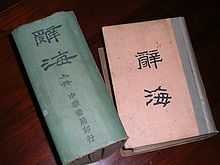Cihai
| Cihai | |||||||||||||
| Chinese name | |||||||||||||
|---|---|---|---|---|---|---|---|---|---|---|---|---|---|
| Simplified Chinese | 辞海 | ||||||||||||
| Traditional Chinese | 辭海 | ||||||||||||
| Literal meaning | sea of words | ||||||||||||
| |||||||||||||
| Korean name | |||||||||||||
| Hangul | 사해 | ||||||||||||
| |||||||||||||
| Japanese name | |||||||||||||
| Kanji | 辞海 | ||||||||||||
| Hiragana | じかい | ||||||||||||
| |||||||||||||
The Cihai is a large-scale Chinese dictionary and encyclopedia. The Zhonghua Book Company published the first Cihai edition in 1938, and the Shanghai Dictionary Publishing House published revised editions in 1979, 1989, 1999, and 2009. A standard bibliography of Chinese reference works (Teng and Biggerstaff 1971:134) calls the Cihai an "outstanding dictionary".
Contents
The Cihai is a semi-encyclopedic dictionary and enters Chinese words from many fields of knowledge, such as history, science, mathematics, philosophy, medicine, and law.
Chinese lexicography dichotomizes two kinds of dictionaries: traditional zidian (字典, lit. "character/logograph dictionary") for written Chinese characters and modern cidian (辭典 "word/phrase dictionary") for spoken expressions. For example, the Hanyu Da Zidian for characters and Hanyu Da Cidian for words. The Cihai, as the title indicates, is a cidian.
The American sinologist George A. Kennedy, who wrote a student's guide to using the Cihai as the basis for sinological studies, said the dictionary's principal values are its (1953:85) "explanations for phrases and compound expressions" and (1953:131) "citations illustrating the use of words and expressions."
History

The Cihai originated when Lufei Kui, founder of the Zhonghua Book Company, decided to publish a comprehensive Chinese dictionary to compete with rival Commercial Press's 1915 Ciyuan (辭源 "source of words") (Wilkinson 2000:89). Under the editorship of Shu Xincheng (舒新城, 1893-1960), over 100 lexicographers worked for two decades to compile the Cihai, which was published in 1936. This 2-volume first edition has over 80,000 entries arranged under single characters in radical-stroke order, with the words and compounds under each character listed by the number of characters and strokes. The definitions are written in wenyan "literary Chinese" (Hartmann 2003:166). The Taiwan branch of Zhonghua published a Cihai reprint in 1956 with minor revisions additions and (Yang 1985:279).
Plans for a second edition began after a 1958 conference about revising the Cihai and Ciyuan. The Cihai Editorial Committee organized over 5000 scholars and specialists to undertake the new compilation, concentrating on revising the first edition entries and adding modern terminology, especially scientific and technical. Reinhard Hartmann (2003:166) describes the editorial work of revising Cihai as taking "a tortuous course, 22 years from start to finish". After the original editor-in-chief Shu Xincheng died in 1960, he was succeeded by Chen Wangdao, who died in 1977, and was succeeded by Xia Zhengnong (夏征农, 1904-2008). From 1961 to 1962, sixteen shiyong (試用 "trial") individual subject-matter fascicles were distributed for comments by specialists, and in 1965 a weidinggao (未定稿 "draft manuscript") Cihai was completed, but the anti-intellectualism of the Cultural Revolution (1966-1976) halted editorial work (Huang et al. 1993:220). Shanghai Dictionary Publishing House (上海辭書出版社) published the three-volume revised edition Cihai in 1979 and a condensed single-volume version in 1980.
The revised 1979 edition has the same title and layout as the original 1936 edition, but serves a much different purpose (Wilkinson 2000:89). The first edition covers China's past and uses literary Chinese for definitions, while the second edition also covers modern China and international matters and uses baihua "colloquial speech". It contains 106,578 entries, totaling more than 13.4 million characters. The single character headwords are arranged under 250 radicals, with subsequent words listed according to stroke numbers. The third volume appends useful charts (e.g., a chronology of Chinese history), tables (weights and measures), lists (Ethnic minorities in China), and a pinyin index to single characters.
The 1989 three-volume edition Cihai was also compiled with Xia Zhengnong as editor-in-chief. It focused upon the addition of 20th-century terms, more proper names, and technical vocabulary. This third edition Cihai contains 16,534 head characters, with more than 120,000 entries, totaling over 15.8 million characters. (Huang et al. 1993:223-224)

The 1999 Cihai contains 17,674 head characters, 122,835 entries, totaling more than 19.8 million characters. This fourth edition dictionary added many color tables and illustrations. Arrangement is by radicals and there are stroke-count, four-corner, pinyin, and foreign-language indexes (Wilkinson 2000:89). It was also published in a compact version.
The 2009 fifth edition Cihai contains more than 127,200 entries, arranged by pinyin, with over 22 million characters total. Chen Zhili replaced Xia Zhengnong as chief editor, and lexicographers deleted about 7,000 entries for outdated terms and added almost 10,000 for neologisms. Volumes 1-4 contain text, with many color illustrations, and Volume 5 contains indexes.
The Dacihai (大辞海 "Great sea of words") is a 38-volume encyclopedia project that began in 2004, and published the first volumes in 2008.
References
- Hartmann, R. R. K. (2003), Lexicography: Reference Works across Time, Space, and Languages, Taylor & Francis.
- Huang Wenxing 黄文兴, et al. (1993), Cishu leidian 辞书类典, Zhongguo guangbo dianshi chubanshe. (Chinese)
- Kennedy, George A. (1953), ZH Guide: An Introduction To Sinology, Far Eastern Publications.
- Teng, Ssu-yü and Biggerstaff, Knight (1971), An Annotated Bibliography of Selected Chinese Reference Works, 3rd ed., Harvard University Press.
- Wilkinson, Endymion (2000), Chinese History: a manual, revised and enlarged ed., Harvard University Asia Center.
- Yang, Paul Fu-mien (1985), Chinese Lexicology and Lexicography: A Selected and Classified Bibliography, Chinese University Press.
External links
- Chinese dictionary 'Cihai' publishes new edition, China Daily, 22 September 2009.
- "Qinghai-Tibet Railway" included in Chinese dictionary "Cihai", Xinhua News Agency, 25. September 2009